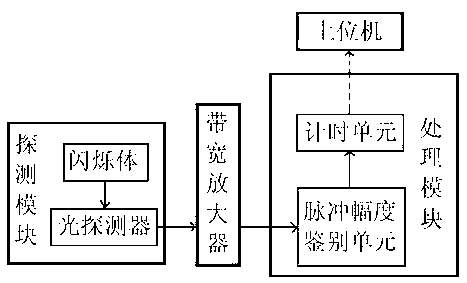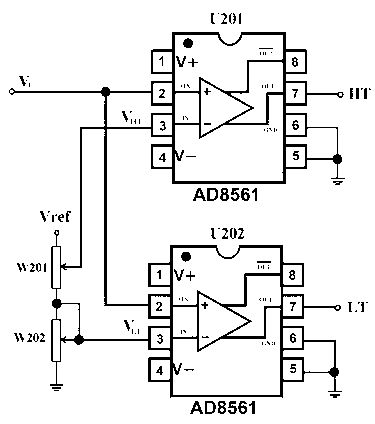Time of exposure non-intervention measuring device and method of X-ray machine
A technology of exposure time and measurement device, which is applied in X-ray equipment, electrical components, etc., can solve the problems of exposure time measurement error, large constant between amplifying circuits, and slow change of ray radiation rate, so as to reduce errors and influence Effect
- Summary
- Abstract
- Description
- Claims
- Application Information
AI Technical Summary
Problems solved by technology
Method used
Image
Examples
Embodiment 1
[0033] Such as figure 1 , X-ray machine exposure time non-interventional measurement device, including a detection module and a processing module, the detection module includes a scintillator and a photodetector, the scintillator is located in the ray radiation area of the X-ray machine, and the photodetector The detection end is close to the scintillator, and its output is connected to the processing module through a bandwidth amplifier. The processing module includes a pulse amplitude discrimination unit and a timing unit. The input of the pulse amplitude discrimination unit is connected to the output of the bandwidth amplifier, and its output connected to the timing unit.
[0034] The scintillator used in this example is a lanthanum bromide crystal (LBC) scintillator doped with cerium chloride. The lanthanum bromide scintillator converts incident rays into optical signals. The light output is 1.3~1.6 times of NaI:TI crystal, the decay time is 1 / 20~1 / 10 of NaI:TI crystal,...
Embodiment 2
[0043] The structure of this embodiment is basically the same as [Example 1], the difference is that the number of counters in the timing unit is 4, and the structure diagram of the timing unit is as follows Figure 7 shown.
[0044] In this embodiment, after the number of counters is increased to 4, the upper limit of the continuous pulse rate of the timing unit is increased.
[0045] The measurement process of this embodiment is basically the same as [Example 1]. When measuring the time interval, four counters are used to measure in turn. When a certain count cannot be counted during the stop / read / reset operation, the pulse The signal can be counted sequentially by the other three counters, thus increasing the upper limit of the continuous pulse rate of the timing unit.
Embodiment 3
[0047] The structure of this embodiment is basically the same as [Embodiment 1]. The difference is that the hardware of the processing module in this embodiment is different, and the analog signal is represented by a data stream, such as Figure 8 As shown, the pulse amplitude identification unit includes an FPGA, and the FPGA is connected to the output of the bandwidth amplifier through an A / D converter, and the A / D converter converts the output voltage signal of the bandwidth amplifier into a digital signal to form a continuous data stream and then transmits it to the FPGA. The size of the data in the stream represents the amplitude of the signal. The FPGA adopts the chip of XC5VSX95T, which is the model of Xilinx. This chip can provide various data preprocessing functions. In this embodiment, XC5VSX95T mainly provides the pulse amplitude identification function, and also uses two comparators , that is: the amplitude of the received data stream below V LT The following is set ...
PUM
 Login to View More
Login to View More Abstract
Description
Claims
Application Information
 Login to View More
Login to View More - R&D
- Intellectual Property
- Life Sciences
- Materials
- Tech Scout
- Unparalleled Data Quality
- Higher Quality Content
- 60% Fewer Hallucinations
Browse by: Latest US Patents, China's latest patents, Technical Efficacy Thesaurus, Application Domain, Technology Topic, Popular Technical Reports.
© 2025 PatSnap. All rights reserved.Legal|Privacy policy|Modern Slavery Act Transparency Statement|Sitemap|About US| Contact US: help@patsnap.com



